History
History
The history of academic pharmacy in Krakow dates back to 1783, when the Department of Pharmacy and Medical Matter was established at the Krakow Academy, known as the “Main Crown School” (Polish: “Szkoła Główna Koronna”), which was reformed by the Commission of National Education. The first professor of this department was Jan Szaster (1746-1793), a Krakow pharmacist and doctor of medicine. In the absence of adequately equipped rooms at the School, Professor Szaster conducted practical classes for pharmacy students in his own “Under the Sun” pharmacy (Polish: “Pod Słońcem”), located at 43 Main Market Square. The pharmacy course at the time took two years and covered knowledge that currently is a part of pharmacy, pharmacognosy, pharmaceutical formulation, hygiene, dietetics, balneology, toxicology and forensic medicine. The first Master of Pharmacy diplomas were issued in 1797, and among the first diploma holders was Józef Sawiczewski (1762-1825), a future professor at Krakow’s Department of Pharmacy and Medical Matter.
In 1805, pharmacy classes at the Krakow university were suspended by the occupying Austrian forces. They were reactivated five years later, in 1810. At that time, lectures on pharmacy, medical matter and hygiene were given by the aforementioned Józef Sawiczewski. He took over the “Under the Sun” pharmacy from Jan Szaster, where he taught practical classes, just like his predecessor. The study course took 1 year in the reactivated department.
August 28, 1824 marks the first time in the history of the world when women were given diplomas in pharmacy. The female graduates completed their studies on extramural basis. These graduates were Filipina and Konstancja Studzińska, nuns from the Congregation of the Sisters of Our Lady of Mercy, working as pharmacists at the university hospital’s St. Barbara pharmacy.
On August 15, 1833, under the Organizational Statute of the Krakow University, the pharmaceutical studies’ program was expanded to three years. On March 29, 1897 marks an important event in the history of pharmacy in Krakow, with the decree by the Minister of Religion and Education, allowing women to be admitted to the university. Jadwiga Klemensiewicz, Janina Kosmowska and Stanisława Dowgiałło were the first rightful female students.
In 1920, the Pharmaceutical Branch at the Faculty of Philosophy was establish at the Jagiellonian University; between 1920 and 1926, the Branch was directed by a chemist, Prof. Karol Dziewoński. The three-year studies curriculum included chemical technology, applied pharmacy, physical chemistry, among others. In the academic year 1922/1923, the first independent Department of Applied Pharmacy was established, headed by Prof. Marek Gatty-Kostyal. From 1926 to 1947, the Pharmaceutical Branch of the Jagiellonian University was headed by Prof. Tadeusz Estreicher.
In 1942, an underground university was organized in Krakow under the code name “Cooperative” (Polish: “Spółdzielnia”), including a Pharmaceutical Institute. After the war, the independent Faculty of Pharmacy of the Jagiellonian University was established on September 9, 1947. In 1949, by a decree of the Polish Council of Ministers, a Medical Academy was created in Krakow, including the Faculty of Medicine, and additionally the Faculty of Pharmacy. By the decision of the Polish Minister of Health of October 1, 1957, a five-year pharmacy degree program was introduced, ending with a master’s thesis.
On May 12, 1993, the Faculty of Pharmacy, along with the other faculties of the Medical Academy, returned to the Jagiellonian University as the Medical College (Latin: “Collegium Medicum”).
The Faculty of Pharmacy currently boasts a complex of buildings at 9 Medyczna Street, used since the 1993/1994 academic year. The complex is conducive to scientific development and provides an adequate standard of teaching activities.
Faculty of Pharmacy of the Jagiellonian University’s Medical College also includes the world’s unique Museum of Pharmacy, located in the center of the Old Town, at 25 Floriańska Street.

